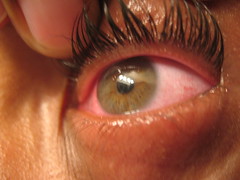According to the Eagle Vision-Yankelovich poll, one out of every five U.S. residents suffer from Dry Eye Syndrome; that’s 59 million Americans!
Dry eye is the most common complication of LASIK. In fact, about half of all LASIK patients will have dry eye after LASIK. While the condition is usually temporary and mild, significant numbers of people continue to suffer from dry eye for months or even years after the procedure.
Many people who have had LASIK had a previously undiagnosed dry eye issue, and the procedure actually exacerbated the problem. For example, contact lens wearers who find their contact lenses uncomfortable due to dry eye, may investigate LASIK as an alternative (since they do not want to wear eyeglasses). They then, regrettably, proceed to LASIK without proper dry eye treatment. Fortunately, pre-LASIK procedure screenings have advanced, and dry eye detection is now a condition that is hopefully detected in advance. However, there are still many, many post LASIK patients who experience dry eye.
Post LASIK Dry Eye Treatment

Dr. Irwin Azman O.D.
Dr. Irwin Azman, who has been in practice for over 30 years, specializes in post LASIK complications and side effects. Dr. Azman, a PRK patient himself, has been involved in refractive surgery for over 20 year and is always committed to staying updated on the latest, most advanced research, education and technologies. Dr. Azman utilizes his knowledge, experience, and expertise to provide his patients with treatments for post LASIK complications and side effects, without further surgical procedures. Each dry eye patient is different, and Dr. Azman utilizes his vast knowledge to customize a treatment program that is tailored for each individual patient.


